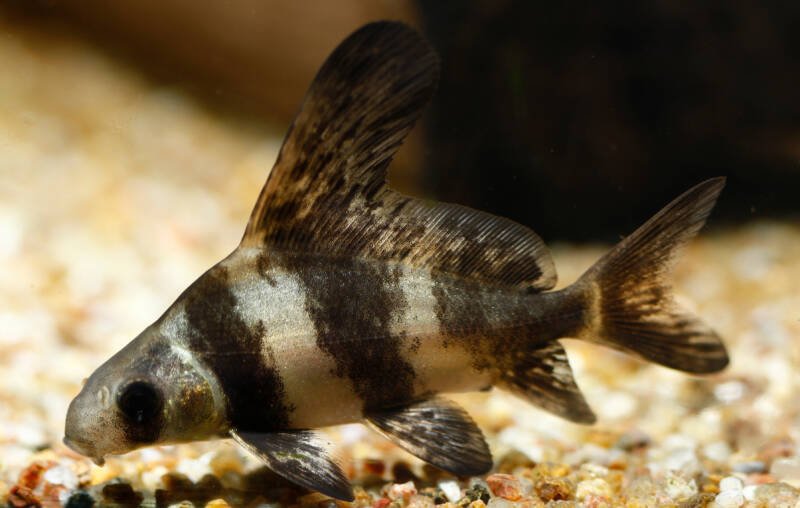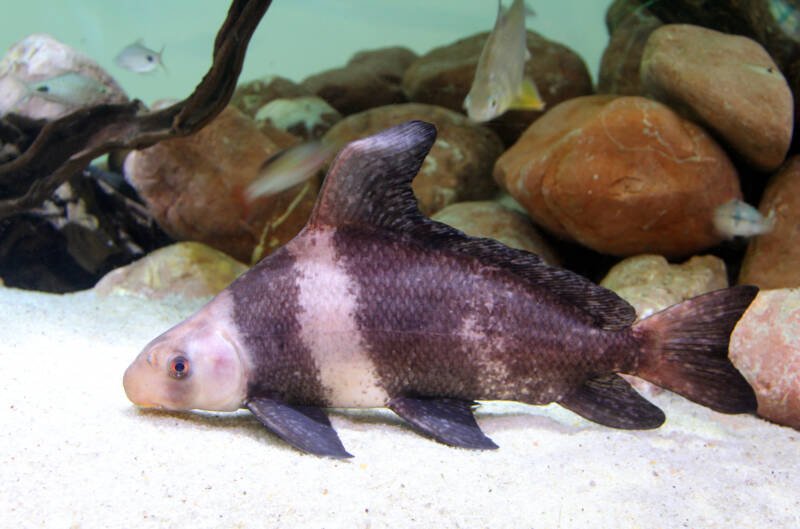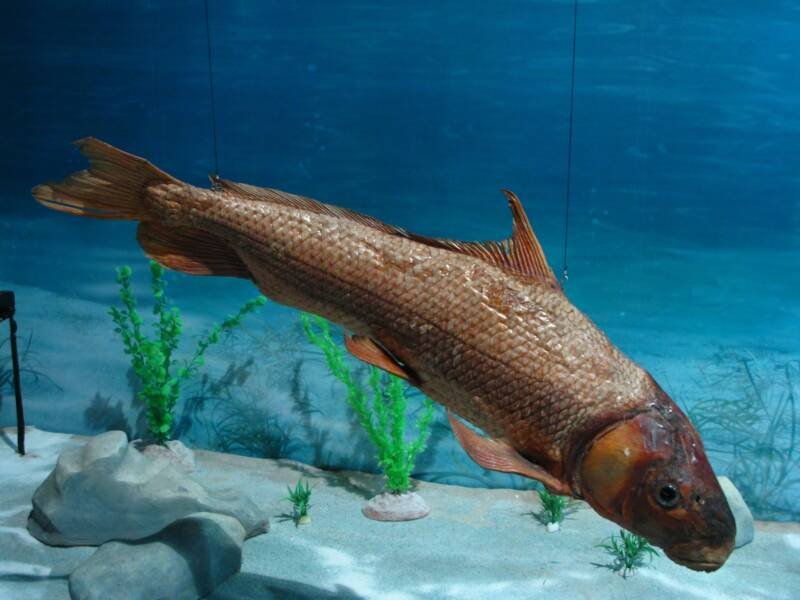Just say the word “shark,” and you immediately imagine the sleek, powerful predator.
Even reading the title to this article, you probably already have a mental picture of the fish we are discussing, even if you have never seen it. Well, throw those pictures out.

Despite its prominent dorsal fin and shark-like profile as a juvenile, the Chinese high fin banded shark (Myxocyprinus asiaticus) is not a shark species at all but is a sturdy, cold water-loving algae eater.
This “freshwater shark” goes by many names, including the topsail sucker, high fin sucker, and Chinese sailfin sucker.
Treasured for its unique appearance and banded coloration as a juvenile, this fish looks completely different as an adult, losing its shark-like form and reaching an impressive size.
It has a peaceful nature, which allows it to be paired with ornamental fish in outdoor ponds as well as large community tanks.
For those thinking of taking this fish on, it does have some special needs as far as water conditions and overall tank size.

Read on for more information on the care of this species.
At a Glance
| Tank Size: | 55 gallons for juveniles, large outdoor pond, or 300-to-800-gallon tank for adults |
| Group Size: | 2 or 3 |
| Water Temperature: | 55 to 75°F (13 to 24°C) |
| pH: | 6.8 to 7.5 |
| Hardness: | 4 to 20 dGH |
| Lifespan: | 10 to 15 years in captivity – in the wild, up to 25 years |
| Breeding: | Difficult in captivity |
| Adult Size: | 4.5 feet (1.4 meters) |
| Usual Place in the Tank: | Bottom |
In this article
Natural Habitat
The Chinese high fin banded shark is endemic to the Yangtze River basin in China.
This high mountain river system flows through elevations ranging from 3,000 to 16,000 feet. The result is cool temperature, occasionally fast-flowing water that is highly aerated.
Considered an endangered species, this fish is protected in China.
Its decline in recent years can be linked to habitat loss, pollution, and overfishing. In addition, dams built along the river prevent its migration to the river’s headwaters to spawn.
Appearance and Biology
This species has distinct differences in its juvenile and adult forms.
As a juvenile, it is only a few inches in length and features attributes that contribute to its common name. Its triangle-shaped dorsal fin is comically high compared to the rest of its body.

Contrasting, splotchy black and white stripes circle the body, and the fins carry over a black and white speckling. Their belly is flat, and their pectoral fins are sharp and point backward.
As they grow to a length around 12 to 14 inches (30 to 36 cm), this fish begins to lose its banded features.

Upon reaching sexual maturity, around five or six years old, they have elongated bodies, a short dorsal fin, and completely different coloration. Males are a dusty red, while females are a deep purple color.

These algae eaters have mouths that are clearly sucker-shaped. Although they lack the barbels of other bottom-feeding fish, they do have small papillae and a single row of pharyngeal teeth.
Size
Within a few short years, these fish grow to a length of eight inches. By age five or six, they are up to 24 inches long.
Their maximum length is up to 4.5 feet (1.4 meters). Naturally, achieving this length depends on the size and quality of the environment in which they are kept.
Lifespan
In the wild, this species has been known to live up to 25 years. In captivity, their lifespan is more in the range of 10 to 15 years.
For your banded shark to reach the upper limit of its lifespan, you must take care to ensure their water conditions are ideal. Otherwise, this species is susceptible to disease.
Behavior
This peaceful fish is more concerned with cruising the tank bottom in search of food than with its tank mates.
They are shoaling fish, so if the size of your enclosure permits, keeping multiple fish is best for their health and sense of security.
How many per gallon?
Although you can get away with raising six juvenile banded sharks in a 55-gallon tank, they will outgrow it within a year or two.
The minimum tank size you should plan on for your adult banded shark is somewhere between 300 to 800 gallons.
If you choose to keep them in a pond and you have the real estate to support their adult size, consider a group of two or three.
Tank Setup
Your ideal tank setup should be geared toward cold water and lots of space.
Can they live in ponds?
The answer is yes. These fish do well in outdoor ponds that contain enough water, think a thousand gallons or more, to let them swim and grow as they would in the wild.
Because they are cool water fish, they can tolerate outdoor conditions year-round in many places.
Decoration
As this is a bottom-dwelling species, start with a high-quality, fine gravel substrate to avoid damage to their undersides.
Select aquarium plants or pond favorites that tolerate cold water, such as java fern, hornwort, or water hyacinth.
Add rocks or driftwood to create hiding spaces, but leave a large, open swimming area.
Water Conditions
Make sure the water temperature stays within 55 to 75 degrees Fahrenheit (13 to 24 degrees C). Temperatures below 40 degrees Fahrenheit can cause your fish to be susceptible to disease.
The pH level should stay between 6.8 to 7.5 and the hardness between 4 to 20 dGH.
Equipment
Select a strong canister filter with a capacity suited for large aquariums. As each outdoor pond setup and requirements are unique, consult your local designer and research the appropriate filter for your pond.
Banded sharks produce a fair amount of waste, and you do not want the ammonia and nitrate levels to get out of control.
This river-dwelling species enjoys a decent water flow rate, so select a filter that can provide one. Install a heater for your outdoor pond if you expect temperatures to be consistently below 40 degrees Fahrenheit over the colder months.
Tank Mates
The best fish to go with your Chinese high fin banded shark are also those that are excellent choices for cool water tanks or outdoor ponds.
The banded shark’s ability to help control algae makes it a favorite to place in ornamental fish aquariums.
Consider the following to pair with your Chinese high fin banded shark:
Avoid the following:
- Warm water, tropical fish, or overly aggressive fish.
Food and Diet
Although they have that characteristic algae eater mouth, this species is a scavenging omnivore. To keep them at their healthiest, their diet should include a variety of plant and protein-based foods.
The base of their diet should be algae (already existing in the tank or pond), which you can supplement with sinking pellets and algae wafers.
These fish will also enjoy cut vegetables, such as zucchini. Finally, treat them with high protein foods, such as:
- Brine shrimp
- Tubifex
- Bloodworms
- Crustaceans
- Insects
- Prawn.
In fact, feeding brine shrimp to your Chinese high fin banded shark can bring out a touch of pink in the fish’s coloration. They will also eat koi pellets and earthworms.
If you notice your fish are not eating, there may be a water quality issue to blame. Try changing out a portion of the water and testing its parameters. Once the water conditions are within range, try feeding your fish again.
Breeding
Breeding banded sharks in captivity can be challenging to nearly impossible, which is good news for those who do not wish to have their fish breed.
In the wild, this species migrates to the Yangtze River’s headwaters, which are shallow and fast-moving, to spawn. As these conditions are difficult to reproduce in a tank or pond setting, there is minimal chance of breeding success.
Captive breeding often involves the use of stimulating hormones and should be done only by those familiar with the process.
For recreational fish keepers, we do not recommend attempting to breed your banded sharks.
Hardiness
The Chinese high fin banded shark is a hardy species, but as with any freshwater fish kept in an aquarium setting, they are prone to certain diseases due to poor water quality and nutrition.
Keep an eye out for common ailments, such as ich, dropsy, and swim bladder disease.
All of these can be treated with medication, but it is important to recognize the signs that your fish is infected and move to isolate and treat them as soon as possible.
Closing Thoughts
While a unique and even helpful species with a wonderfully peaceful disposition and a tolerance for cold, the Chinese high fin banded shark is not the best choice for every aquarium keeper. There are a couple of reasons for this.
First, before you get attached to one of these striped cuties as a small, juvenile fish, know that they will eventually grow to a considerable adult size.
Add to this the fact that they need to be kept in groups, and you can see that there is a significant tank or pond size requirement.
If you cannot commit to the size needed for this fish to grow in a healthy way, then this is not the species for you.
Second, this species is considered endangered in China, mostly due to overdevelopment, overharvesting, and pollution.
Do some research on the breeders and take care when selecting your fish to ensure that the wild populations of the species are ethically preserved.
We would love to hear from you!
If you have kept Chinese high fin banded sharks, were they in a pond or large aquarium?
What is your favorite filter to keep the water conditions clean?